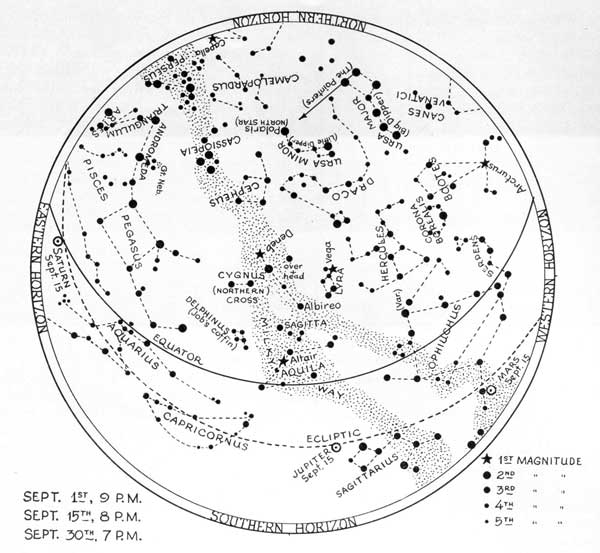What's Happened to the Martian Atmosphere?
Strange phenomenon observed by scientists at Lowell Observatory may be due to sunspot activity
By ISABEL M. LEWIS
Nature Magazine, September 1937
Page 1 | Page 2
It was on May 20 and 21 of this year, when the ruddy planet Mars was just past opposition with the sun, and about a week before its closest approach to the earth for this return, about 47,200,000 miles, that a most remarkable change in the atmosphere of the planet was observed at the Lowell Observatory at Flagstaff, Arizona. So important did Dr. E. C. Slipher of the Observatory consider the photographic records of the phenomenon that he calls attention to it in an article, illustrated by photographs of the observed change, in the June number of the Publications of the Astronomical Society of the Pacific that other astronomers might be on the watch for further developments.
Photographs of the planet taken in blue and violet light had shown, until the change was recorded, the usual characteristics of such. photographs: cloudiness and veiling of the surface features of the planet by its atmosphere. Then suddenly, within a few days, a remarkable transparency in the Martian atmosphere was observed over an enormous area. It manifested itself in the photographs taken in blue light as huge dark regions, breaks in an atmosphere normally opaque to the short blue and violet wave-lengths of light, through which dark markings on the surface of the planet could be seen.
Photographs in blue light usually show little if any trace of the surface features of the planet such as appear in photographs taken in yellow light that readily penetrates the haze that shuts out rays of shorter wave-length. So remarkable was the change recorded in the blue-light photographs that they might have been assumed upon a first glance to be photographs taken in yellow light.

According to Dr. Slipher, no change so remarkable as this phenomenon has been observed in the atmosphere of Mars during the many years that photographic records of this planet have been kept at Flagstaff. It indicates a state of most unusual transparency in the Martian atmosphere over a great area. Comparisons of the photographs were made with similar ones taken in blue light in previous years as far back as 1922 and show that the Syrtis Major, the largest and most conspicuous of all markings on the surface of Mars, may be seen more clearly in the photographs taken at this opposition in blue light than at any earlier time for which there is a comparable record.
Blue photographs made on the same type of plate on April 20 of this year show no trace of the Syrtis Major but father a cloudy condition of the planet's atmosphere. The same face of the planet photographed in blue light on other occasions shows almost complete screening of the surface features of the planet, due to the opaqueness of the atmosphere to blue light, while the photographs taken in May show a most unusual transparency in the planet's atmosphere over a great area.
Cloud patches were observed on other portions of the planet's disk, and in the south polar region of the planet there was a noticeable change in the size and brightness of the cloudy area between the nights of May 20 and 21, showing that the change in the opaqueness of the atmosphere occurred only in certain areas. This proved the phenomenon was not due to a condition existing in our own atmosphere since the usual cloudiness and haziness were visible over other parts of the Martian surface. As the same telescope and equipment and same kind of plates were used for all these photographs, it was evident that the change observed was due to a great variation in the transparency of the Martian atmosphere. Though variations in the transparency have been observed on other occasions, there have been none so remarkable as that of the present year. Until the reports of other observers of this planet are available it will not be known for how long this change in the transparency of the planet's atmosphere was observable or how frequently it occurred during this spring and summer. The planet now is getting too far from the earth for favorable observation of its surface features or atmosphere, and another two years will pass before the planet is well placed for such observation.
Page 1 | Page 2
 Printer-friendly version
Printer-friendly version
